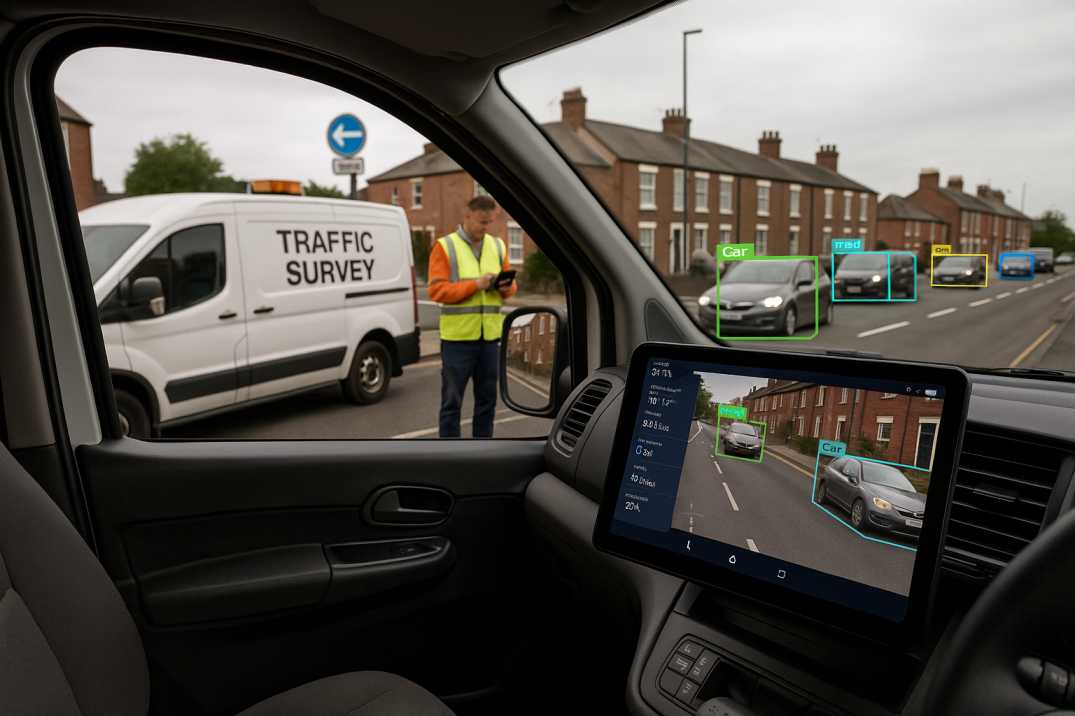Contact Us
RoadVision AI
Private Limited
Office No. 308 & 310, B Block
Ansal Chamber - 1, Bhikaji Cama Place,
Near Engineers India Limited (EIL) Bhawan, New Delhi - 110066
© 2024 | RoadVision AI | All rights reserved
Local transport planning UK is undergoing a fundamental transformation. Strategic plans such as Local Transport Plans (LTPs) now require robust data, predictive analytics, and efficient road asset management UK. With new standards like PAS 2161 and the DfT Transport Data Strategy, AI-driven digital traffic monitoring and road survey automation UK are essential tools for future‑ready transport authorities.

The Department for Transport’s Local Authority Transport Data Guidance (LATDG) and its broader Transport Data Strategy outline principles for transport data sharing, catalogue creation, and real‑time usage by highway authorities.
PAS 2161, released in September 2024, sets new standards for road condition monitoring across England, encouraging consistent, high‑quality data for local authority and trunk roads.
Meanwhile, the Design Manual for Roads and Bridges (DMRB) and National Highways’ GM 701 guidelines specify how traffic, geometry, pavement condition, and asset maintenance data must be gathered and managed as part of road asset management UK.
LTPs require baseline data on congestion patterns, traffic volumes, safety incidents, and modal split across years. Digital traffic monitoring and AI traffic survey tools provide automated, continuous data capturing daily flows, speeds, classifications, and movement trends to support LTP objectives.
Traditionally, surveys were manual and infrequent. Modern ai traffic monitoring systems automate vehicle counts, detect incidents, monitor signal performance, and classify vehicle types in real time. This supports compliance with GM 701 and PAS 2161 by delivering precise, repeatable measurements for road asset management UK.
Under the Traffic Management Act 2004, local highway authorities must secure the expeditious movement of traffic. AI traffic flow management enables dynamic adjustments—signal optimisation, congestion alerts, rerouting—to uphold this duty effectively.
AI-driven systems offer predictive modelling to anticipate congestion, hotspot analysis for safety, and seasonal forecasting. These insights help transport planners make informed interventions aligned with DfT guidance.
Quality traffic data supports targeted maintenance, prolongs pavement life, informs traffic signage needs, and guides lifecycle planning based on DfT and UK Roads Liaison Group asset management principles.
Emerging DfT requirements on low‑traffic neighbourhoods and 20 mph zones now emphasize local stakeholder engagement and pre and post data evidence backing proposals. AI-enabled surveys offer transparent quantifiable data to support community consultations and scheme design.
RoadVision AI delivers comprehensive solutions for traffic survey, road inventory inspection, pavement condition survey, and road safety audit. Local authorities and transport planners can leverage these tools to:
Transport policy is shifting toward integrating emerging technologies like automated vehicles, active travel, and data-driven designs. Government horizon scanning emphasizes the need for transport planning frameworks to harness these technologies effectively.
AI-based digital traffic monitoring and traffic flow management will underpin future LTPs, ensuring resilient, efficient and inclusive transport systems.
The future of local transport planning UK hinges on embracing digital traffic monitoring, and road survey automation UK. These tools deliver the high‑quality, continuous data needed to meet statutory planning obligations, improve road asset management UK, and support community‑centred interventions. RoadVision AI’s platform positions UK transport authorities to lead this transformation.
RoadVision AI is leading innovation in AI in road maintenance, providing a smart, automated solution for managing road networks. It conducts detailed traffic surveys and generates high-quality road data for early detection of issues such as surface cracks and the need for potholes repair. This technology-driven platform brings the power of AI in road planning and monitoring to enhance road safety. Fully compliant with IRC Codes and aligned with UK Highways Agency standards, RoadVision AI supports infrastructure planning that meets the needs of modern UK road networks.
Book a demo with us.
Q1. What is AI traffic survey and why is it better than manual surveys?
AI traffic survey uses sensors, cameras, and computer vision to collect detailed traffic metrics continuously. It is more accurate, scalable, and cost-effective than manual counting.
Q2. How does digital traffic monitoring support road asset management in the UK?
By providing reliable volume, speed, and usage metrics, digital monitoring helps identify maintenance needs, optimise lifecycles, and comply with PAS 2161 and GM 701 asset standards.
Q3. Can AI traffic flow management improve compliance with Traffic Management Act duties?
Yes. It enables dynamic signal timing, congestion alerts, and rerouting, helping highway authorities secure the expeditious movement of traffic as required by the Traffic Management Act 2004.